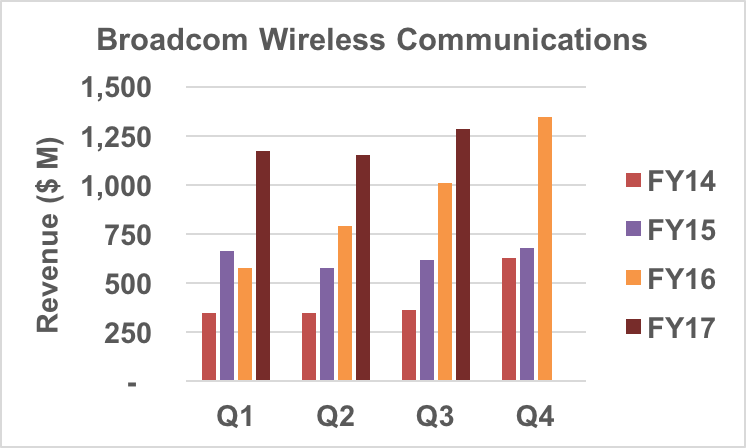Here’s my summary of industry-related news from the past week, news that I think is worth paying attention to.
Companies and Products
Broadcom’s Q3 wireless segment revenue was $1.28 billion, which was up 12 percent from the prior quarter and 27 percent above the prior year’s quarter. The company attributed the growth to the iPhone 8 ramp and said it had secured a “large increase” in dollar content.

Despite market and financial challenges, Ericsson ranked as the top microwave radio supplier in a survey of mobile operators conducted by IHS Markit.
Integra Devices received an NSF contract to develop electromechanical energy harvesters, which will be used to power wireless sensors and eliminate batteries.
Lockheed Martin and Raytheon won Air Force contracts to develop the next nuclear cruise missile for long-range bombers. Boeing, the manufacturer of the current version (AGM-86B), lost out.
Raytheon’s AMDR radar successfully acquired and tracked a complex target in the second ballistic missile test of the radar.
For millimeter wave applications, Rogers introduced new laminates: a ceramic filled, woven-glass reinforced PTFE composite, with options from 3 to 10 mils thick. The use of spread glass and high filler loading minimize the high frequency glass weave effects on electromagnetic wave propagation.
TowerJazz announced that the 24 GHz rear and side radar sensors on the latest Toyota Camry model use its 0.18 μm SiGe process (SBC18 ).
Wolfspeed reported strong growth in fiscal Q4 2017, generating $60.8 million in revenue, which was 30 percent greater than the same quarter in fiscal 2016 and 8 percent more than Q3. The growth reflects strong demand for SiC diodes and MOSFETs for electric vehicles and battery storage, which exceeded Wolfspeed’s capacity and prompted plans to double SiC materials and fab capacity.
Markets and Technology
Antenna Technology — Researchers at Northeastern University demonstrated piezoelectric and piezomagnetic membranes that convert electromagnetic waves (EM) to mechanical vibrations and back to EM waves. This capability has the potential to enable very small antennas — possibly a thousandth of an EM wavelength — since the acoustic wavelengths are much shorter than their EM counterparts.
Cellular and 5G — Gartner reported that Q2 smartphone shipments increased 7 percent year-over-year to 366 million. Samsung led with 22 percent share, followed by Apple (12 percent), Huawei (9.8 percent), Oppo (7.1 percent) and Vivo (6.6 percent). Both Samsung and Apple lost share year-over-year, although Samsung’s shipments increased.
In the race to claim the fastest Gigabit LTE, Verizon, Ericsson and Qualcomm achieved a 1.07 Gbps peak download data rate using 12 LTE streams, three cell carrier aggregation, 20 MHz FDD carriers, 4x4 MIMO and 256-QAM. This was a lab trial, with conditions optimized.
In the real world, China Unicom and Ericsson launched a Gigabit LTE network, which included LTE broadcast capability — demonstrated by viewing streaming VR video on a high speed train. China Unicom is setting up Gigabit LTE networks in Guangdong, Hainan, Shandong and Beijing and conducting trials in Sichuan, Hubei, Shanxi, Jilin and Jiangsu province.
5G Americas published a free white paper discussing the status of LTE deployment and 5G development: LTE to 5G: Cellular and Broadband Innovation.
Nokia launched the 5G Mobile Network Architecture (5G MoNArch) research project, which aims to put the 5G mobile network architecture into practice by implementing 5G use cases in real world testbeds. Nokia is working with 14 industrial and academic partners.
Also from Nokia: simulating how 5G will work on a high speed train traveling more than 400 km/hr (250 m/hr). It's a real use case in China.
Continuing their series on 5G, IEEE Spectrum published a tutorial and video explaining how small cells will improve millimeter wave coverage.
Broadband — Alaska Airlines picked Gogo's satellite inflight Wi-Fi system, branded 2Ku, for all of Alaska's Boeing and Airbus planes. 2Ku provides global coverage, and Gogo says it has the bandwidth to enable passengers to stream video.
Self-Driving Cars — I find the implications of self-driving vehicles on cities, our love of cars and company business models as interesting as the technology. Ken Washington, Ford's new CTO, recently shared his views about the development challenges and implications for the auto industry.
China — China is protesting the Trump administration’s investigation into alleged theft of U.S. IP. After tough talk during the presidential campaign, this is the first move by the president to challenge Chinese trade practices.
Thoughts? Please share them by leaving a comment below.

